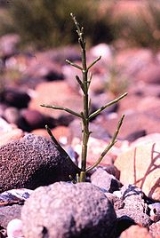
Salicornioideae
Encyclopedia
The Salicornioideae is a subfamily of the Amaranthaceae
, formerly in family Chenopodiaceae
.
s, growing in coastal or inland saline habitats.
of the subfamily. They originated in Eurasia about 38-28 million years ago (Late Eocene
/Early Oligocene
) and radiated rapidly. Already in the Middle Miocene
, about 19-14 million years ago, all major lines were present.
Amaranthaceae
The flowering plant family Amaranthaceae, the Amaranth family, contains about 176 genera and 2,400 species.- Description :Most of these species are herbs or subshrubs; very few are trees or climbers. Some species are succulent....
, formerly in family Chenopodiaceae
Chenopodiaceae
Chenopodiaceae were a family of flowering plants, also called the Goosefoot Family. They are now included within family Amaranthaceae. The vast majority of Chenopods are weeds, and many are salt and drought tolerant. A few food crops also belong to the family: spinach, beets, chard, quinoa, and...
.
Description
The Salicornioideae have articulated, succulent stems and strongly reduces leaves. The flowers are aggregated in thick, dense spike-shaped thyrses.Distribution
Plants from the Salicornioideae are found around the world. All are halophyteHalophyte
A halophyte is a plant that grows where it is affected by salinity in the root area or by salt spray, such as in saline semi-deserts, mangrove swamps, marshes and sloughs, and seashores. An example of a halophyte is the salt marsh grass Spartina alterniflora . Relatively few plant species are...
s, growing in coastal or inland saline habitats.
Evolution
Molecular data supports the monophylyMonophyly
In common cladistic usage, a monophyletic group is a taxon which forms a clade, meaning that it contains all the descendants of the possibly hypothetical closest common ancestor of the members of the group. The term is synonymous with the uncommon term holophyly...
of the subfamily. They originated in Eurasia about 38-28 million years ago (Late Eocene
Eocene
The Eocene Epoch, lasting from about 56 to 34 million years ago , is a major division of the geologic timescale and the second epoch of the Paleogene Period in the Cenozoic Era. The Eocene spans the time from the end of the Palaeocene Epoch to the beginning of the Oligocene Epoch. The start of the...
/Early Oligocene
Oligocene
The Oligocene is a geologic epoch of the Paleogene Period and extends from about 34 million to 23 million years before the present . As with other older geologic periods, the rock beds that define the period are well identified but the exact dates of the start and end of the period are slightly...
) and radiated rapidly. Already in the Middle Miocene
Miocene
The Miocene is a geological epoch of the Neogene Period and extends from about . The Miocene was named by Sir Charles Lyell. Its name comes from the Greek words and and means "less recent" because it has 18% fewer modern sea invertebrates than the Pliocene. The Miocene follows the Oligocene...
, about 19-14 million years ago, all major lines were present.
Genera
It contains 15 genera. with about 90 species. .- AllenrolfeaAllenrolfeaAllenrolfea is a monotypic plant genus containing the single species Allenrolfea occidentalis, the iodinebush. This is a low-lying shrub of the Southwestern United States, California, Idaho, and northern Mexico....
, Americas, with 3 species - Arthrocnemum, Africa, Asia, and Europe, with 2 species
- Halocnemum, Asia and Europe, with one species
- Halocnemum strobilaceum
- Halopeplis, Africa, Asia, and Europe, with 3 species
- Halosarcia (sometimes included in TecticorniaTecticorniaTecticornia is a genus of succulent, salt tolerant plant largely endemic to Australia. In 2007, the genus Halosarcia, along with three other Australian genera was incorporated intothe genus....
), with about 25 species - Halostachys, Asia, with one species
- Halostachys belangeriana
- Heterostachys, Central and South America, with 2 species
- Kalidium, Asia and Europe, (Syn.: Kalidiopsis Aellen), with 6 species
- Microcnemum], Asia and Spain, with one species
- Microcnemum coralloides
- Pachycornia (sometimes included in TecticorniaTecticorniaTecticornia is a genus of succulent, salt tolerant plant largely endemic to Australia. In 2007, the genus Halosarcia, along with three other Australian genera was incorporated intothe genus....
), with one species- Pachycornia triandra
- Salicornia, with 15 species
- SarcocorniaSarcocorniaSarcocornia is a genus of succulent salt tolerant coastal plants.-Species:*S. alpini*S. blackiana *S. fruticosa*Sarcocornia globosa...
, with about 20 species - Sclerostegia (sometimes included in TecticorniaTecticorniaTecticornia is a genus of succulent, salt tolerant plant largely endemic to Australia. In 2007, the genus Halosarcia, along with three other Australian genera was incorporated intothe genus....
), with 5 species - TecticorniaTecticorniaTecticornia is a genus of succulent, salt tolerant plant largely endemic to Australia. In 2007, the genus Halosarcia, along with three other Australian genera was incorporated intothe genus....
, with 3 species - Tegicornia (sometimes included in TecticorniaTecticorniaTecticornia is a genus of succulent, salt tolerant plant largely endemic to Australia. In 2007, the genus Halosarcia, along with three other Australian genera was incorporated intothe genus....
), with one species- Tegicornia uniflora in Australia

